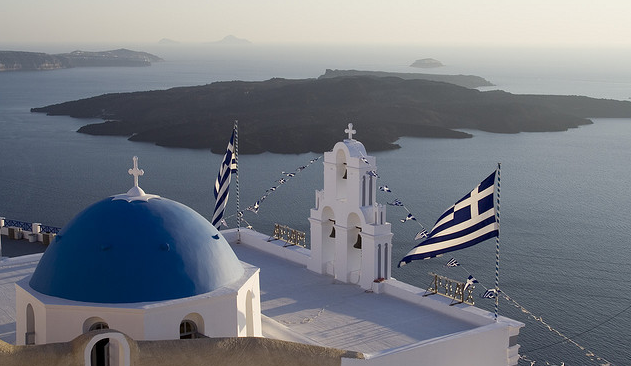The flag of Greece has nine equal horizontal stripes of blue alternating with white, along with a blue canton in the upper hoist side corner bearing a white cross. The ratio of the flag is 2:3.
The shade of blue used in the flag of Greece has changed over time from light blue to the darker blue used today. The flag of Greece was officially adopted by the First National Assembly at Epidaurus on 13 January 1822. White and blue are said to symbolise the skies and the seas of Greece.
The nine stripes are said to represent both the nine syllables in the phrase Ελευθερία ή Θάνατος (meaning "Freedom or Death") as well as the nine letters in the word ελευθερία (meaning "Freedom). The cross represents Greece's national religion of Eastern Orthodox Christianity.
The flag of Greece is referred to as the Γαλανόλευκη, Galanólefki (meaning "Blue and White") or the Κυανόλευκη, Kyanólefki (meaning "Sky Blue and White").
The Greek Flag Day is on 27 October.
Use of the Greek flag is regulated by Law 851, which states:
- When displayed at the Presidential Palace, the Hellenic Parliament, the ministries, embassies and consulates of Greece, schools, military camps, and public and private ships as well as the navy, the flag must:
- Fly from 8am until sunset,
- Be displayed on a white mast topped with a white cross on top of a white sphere,
- Not be torn or damaged in any way. If the flag is damaged, it should be burned in a respectful manner.
- The flag can be displayed by civilians on days specified by the ministry of internal affairs, as well as in sporting events and other occasions of the sort.
- When displayed vertically, the canton must be on the left side of the flag from the point of view of the spectator.
- The flag should never be:
- Defaced by means of writing or superimposing any kind of image or symbol upon it,
- Used to cover a statue. In that case, cloth in the national colours must be used,
- Hung from windows or balconies without the use of a mast,
- Used for commercial purposes,
- Used as a logo for any corporation or organization, even at different proportions.
- When placed on top of a coffin, the canton must always be on the right of the person's head.

Greece flags flying across the nation's skies and seas that it is said to represent
 WARNING - Flag Bazaar flags are lightweight and are not suitable for extended use on flagpoles
WARNING - Flag Bazaar flags are lightweight and are not suitable for extended use on flagpoles